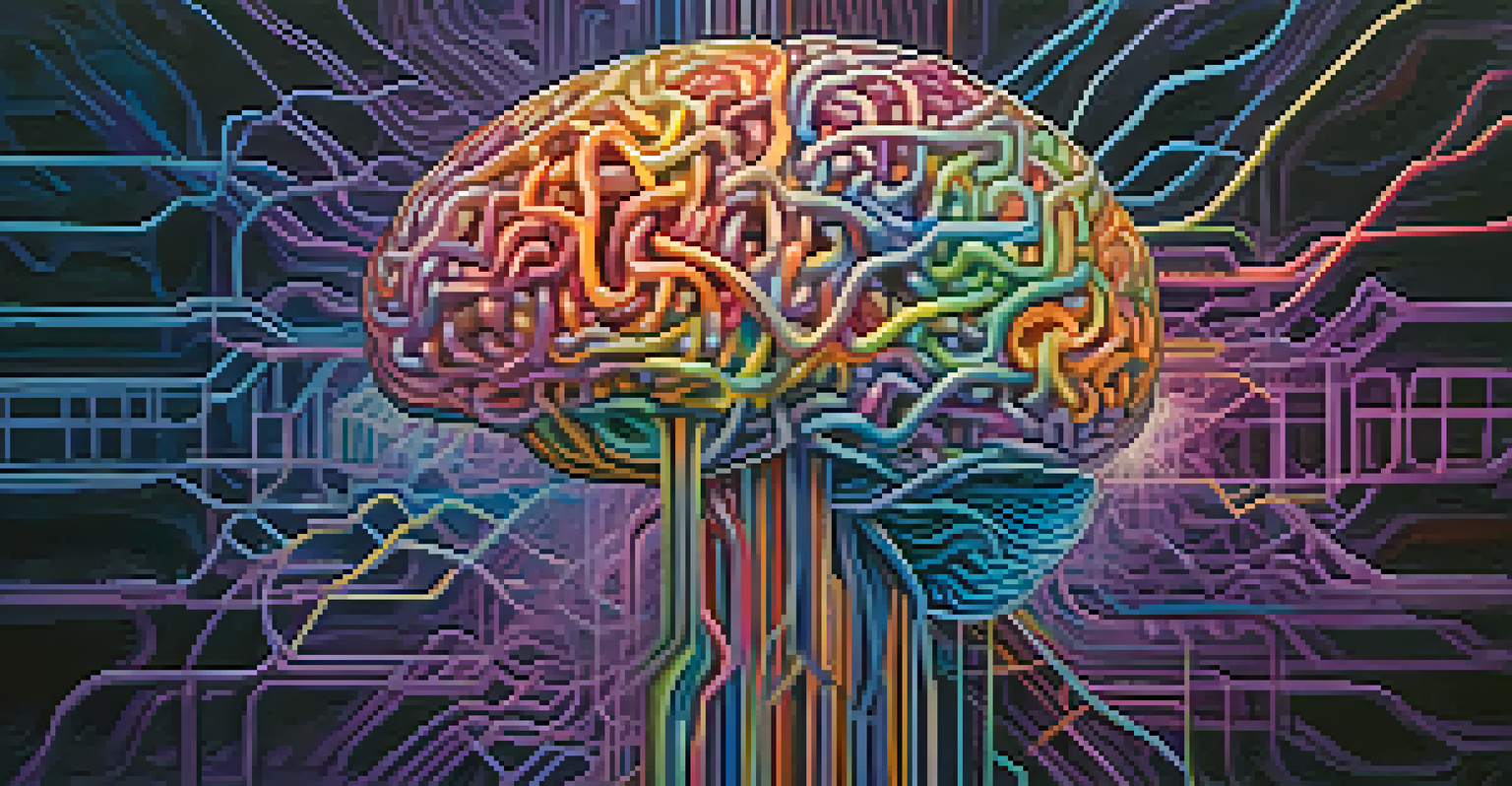Exploring the Connection Between Neuroscience and Psychology

Defining Neuroscience and Psychology: A Brief Overview
Neuroscience focuses on the biological aspects of the brain, aiming to understand how brain structures and functions affect behavior and cognition. Psychology, on the other hand, explores the human mind, emotions, and behaviors, often delving into social and environmental influences. Together, these fields create a comprehensive picture of human experience, blending the biological with the psychological.
The mind is everything. What you think you become.
Consider neuroscience as the hardware of a computer – the physical components that make it run. Psychology, in contrast, represents the software – the programs and applications that utilize the hardware to perform tasks. This analogy highlights how both fields are interdependent, each offering insights that enhance the understanding of the other.
The collaboration between neuroscience and psychology has paved the way for advancements in mental health treatments, cognitive therapy, and educational strategies. By marrying these two disciplines, we can gain a deeper insight into why we behave the way we do and how to improve mental well-being.
How Neuroscience Enhances Psychological Understanding
Neuroscience provides psychological theories with a biological foundation. For instance, understanding neurotransmitters like dopamine can help explain behaviors associated with motivation and reward. This connection allows psychologists to ground their theories in the workings of the brain, lending greater credibility and relevance to their findings.

Moreover, advancements in neuroimaging techniques, such as fMRI and PET scans, have allowed researchers to visualize brain activity during psychological experiments. This technology provides real-time data, giving us a glimpse into how different areas of the brain respond to various stimuli or tasks, enriching our understanding of psychological processes.
Neuroscience and Psychology Unite
The collaboration between neuroscience and psychology enhances our understanding of human behavior and mental health.
For example, studies have shown that specific brain regions are activated when individuals experience emotions like fear or happiness. By linking these emotional responses to brain activity, psychologists can develop more effective therapeutic interventions tailored to individual needs, ultimately enhancing treatment outcomes.
Psychology's Role in Shaping Neuroscience Research
While neuroscience informs psychology, the reverse is equally true. Psychological theories often guide neuroscientific research by highlighting areas of interest and potential avenues for exploration. For instance, the study of anxiety disorders has spurred numerous neuroscience studies aimed at uncovering the underlying neural mechanisms.
Neuroscience is the science of how the brain works, and psychology is the science of how we think and feel. Together, they are the keys to understanding human behavior.
In this way, psychology acts as a compass for neuroscientific inquiry, directing researchers to the most pressing questions about human behavior and mental health. By understanding psychological frameworks, neuroscientists can develop hypotheses that are grounded in real-world observations and experiences.
This collaboration has led to significant breakthroughs, such as identifying the neural correlates of memory formation, which can inform both psychological theory and practical applications in education and therapy. As both fields evolve, their interdependence continues to drive innovation and discovery.
Exploring Mental Health Through Neuroscience and Psychology
The intersection of neuroscience and psychology is particularly prominent in the realm of mental health. By understanding the biological underpinnings of mental disorders, such as depression or schizophrenia, practitioners can create more effective treatment plans. This holistic approach recognizes that mental health issues are influenced by both neural mechanisms and psychological factors.
For instance, research has shown that cognitive-behavioral therapy (CBT) can induce measurable changes in brain activity, demonstrating the tangible effects of psychological interventions. This realization emphasizes the importance of integrating therapeutic practices from psychology with biological insights from neuroscience.
Role of Neuroplasticity in Healing
Neuroplasticity allows the brain to adapt and change, enabling effective therapeutic strategies for mental health recovery.
Furthermore, the collaborative efforts of both fields have led to the development of new medication and therapy options, providing hope and relief for many individuals struggling with mental health challenges. By continuing to explore this rich connection, we can enhance our understanding and treatment of psychological disorders.
The Importance of Neuroplasticity in Psychology
Neuroplasticity, the brain's ability to reorganize itself by forming new neural connections, is a pivotal concept that bridges neuroscience and psychology. This phenomenon allows individuals to adapt their behavior and thought patterns in response to new experiences, learning, and recovery from injury. By understanding neuroplasticity, psychologists can create strategies that promote healthy brain function and mental resilience.
Think of neuroplasticity like a road network: just as new routes can be established to improve navigation, the brain can create and strengthen pathways to enhance cognitive and emotional skills. This understanding opens up exciting possibilities for rehabilitation therapies and cognitive training programs.
For example, therapies that focus on mindfulness and cognitive restructuring can harness neuroplasticity to help individuals develop healthier thought patterns and coping strategies. By fostering an awareness of how the brain can change, psychologists empower clients to take an active role in their mental health journey.
The Role of Technology in Neuroscience and Psychology
Modern technology is revolutionizing the way neuroscience and psychology intersect. From advanced neuroimaging tools to mobile apps that track mental health, technology is providing unprecedented opportunities for research and clinical practice. These innovations help bridge the gap between theoretical knowledge and real-world applications.
For instance, wearable devices can monitor physiological responses and provide data that can be analyzed alongside psychological assessments. This fusion of information allows for a more comprehensive understanding of how physical states influence mental health and vice versa.
Technology Transforms Research
Modern technology is revolutionizing the intersection of neuroscience and psychology, providing new tools for research and treatment.
Additionally, technology enables researchers to conduct large-scale studies that were previously impractical. Online surveys and data collection tools allow for diverse participant engagement, enhancing the generalizability of findings and fostering a more inclusive approach to understanding human behavior.
Future Directions: Bridging Neuroscience and Psychology
As we continue to explore the connection between neuroscience and psychology, exciting future directions are emerging. The integration of artificial intelligence and machine learning in research promises to uncover new patterns and insights that can enhance our understanding of the brain and behavior. This technological advancement holds the potential to accelerate discoveries and refine therapeutic approaches.
Moreover, interdisciplinary collaboration is becoming increasingly important. By bringing together experts from both fields, we can tackle complex questions that require a multifaceted approach. This collaboration may lead to innovative interventions that can better address the nuances of mental health and cognitive functioning.

Ultimately, the ongoing dialogue between neuroscience and psychology will continue to enrich our understanding of the human experience. By remaining open to new ideas and methodologies, we can unlock the mysteries of the mind and improve mental well-being for individuals and communities alike.